#scraping Fresh Direct grocery delivery data
Explore tagged Tumblr posts
Text
Elevate Your Grocery e-Stores Digital Strategy with the Power of Grocery Data Scraping
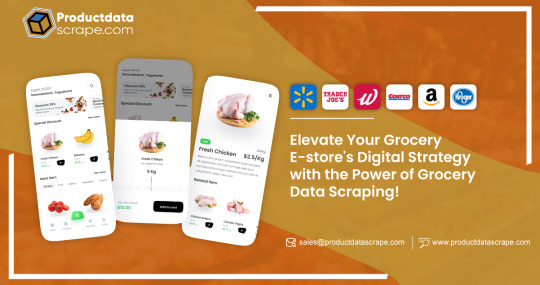
Digital retail has ushered in a transformative shift in consumer purchasing patterns and expectations, particularly in food and grocery markets. Projections indicate that the digital grocery sector will burgeon into a $203 billion market in the U.S. by 2025. Factors such as the pandemic and inflation have propelled more consumers toward e-stores, seeking the dual benefits of convenience and competitive pricing. Presently, major grocery and Consumer Packaged Goods (CPG)/Fast-Moving Consumer Goods (FMCG) brands have established and sustained a robust online presence. They distribute their products across prominent eCommerce platforms, Direct-to-Consumer (DTC) websites, and dedicated grocery applications.
In 2022, online grocery sales constituted 10.5% of the U.S. e-grocery market. Forecasts indicate a gradual ascent, with online grocery sales projected to reach a 12.6% share by 2027, underscoring the sector's sustained digital expansion.
However, a noteworthy development since 2022 has been the swifter escalation of online grocery prices compared to other eCommerce categories. It has intensified the quest for cost-effective alternatives among digital shoppers using grocery data scraping services , a considerable portion of whom belong to the price-sensitive millennial demographic. Consequently, grocery retailers seek productive, dependable, and profitable digital strategies. This pursuit encompasses comprehensive assessments of existing retail management systems and capabilities, ensuring they can adeptly meet demand and outpace competitor activities.
Despite a swiftly evolving industry, success hinges on critical considerations. Parameters such as quality, price competitiveness, convenience vis-a-vis customer loyalty, and the dynamic interplay between private labels and cherished brands have emerged as pivotal determinants. Scrape grocery delivery data to navigate these considerations has been imperative for brands striving to carve their niche in digital grocery retail's dynamic and competitive landscape.
Mastering Success In Online Grocery: Seven Key Strategies

In business, gauging success often involves scrutinizing financial metrics like sales growth, market share, and efficiency. Yet, these indicators are in a set of discernible "preference drivers" reflecting contemporary customer needs and industry trends. In the fiercely competitive and ever-evolving grocery landscape, retailers positioning themselves atop the digital shelf have adeptly aligned with these drivers.
Price & Discounts: Amidst the economic uncertainties of 2023, an upswing in price-conscious shoppers has underscored the pivotal role of pricing. Strategic discounting becomes a linchpin in the digital arena, where consumers can swiftly locate the best-priced products. Clear, enticing promotions on critical items, savvy psychological pricing, and incentivizing customer loyalty through cashback and exclusive discounts emerge as potent strategies to sustain shopper engagement.
Quality:The perception of value is intricately woven with quality, presenting a multifaceted spectrum ranging from the freshness of produce to the treatment of shoppers. Private label products leverage cues from positioning, packaging, and store ambiance to communicate quality and appeal to budget-conscious shoppers. Holistic brand experiences, post-purchase satisfaction, and overall convenience contribute to this notion of quality.
Digital: Digital channels stand as indispensable for retail triumph. Retailers wielding platforms that deliver personalized, flexible, and efficient experiences gain a competitive edge. Seamless online experiences encompass accurate recommendations, interactive chatbots, easy navigation, and a robust omnichannel connection. Mimicking the in-store sense of exploration in the digital sphere becomes paramount for maximizing sales.
Operations: The nuts and bolts of retail operations, including inventory management, assortment planning, and store layout, form the backbone of effective functioning. Enriched product content with explicit imagery, detailed descriptions, real-time pricing, and availability data on digital platforms proves pivotal. Ineffective inventory management risks stockouts of high-demand items, jeopardizing Search Engine Results Page (SERP) rankings and customer satisfaction.
Convenience & Speed: Proximity, diverse product selections, and trendy assortments position a store as a one-stop shop. However, in the digital age, convenience and speed take center stage. Quick, flexible checkout options and efficient shipping, pickup, and returns empower customers to make informed decisions swiftly. Offering multiple shipping and return choices caters to a broad consumer base. Millennials and Gen Z prioritize rapid shipping, while delivery charges emerge as a critical deterrent across other demographics.
Diversification: A spectrum of services and diverse store offerings, coupled with operational efficiency, emerges as the linchpin for long-term success in the grocery e-store landscape. It caters to evolving consumer needs and ensures resilience in a competitive market.
Customer Experience: At the core of success lies an unparalleled customer experience—personalization, convenience, and responsiveness foster customer loyalty. Striving for an optimal balance between technological innovation and the human touch establishes a winning formula in the digital grocery industry.
Leading Grocery Retailers In 2023: Strategies For Success

Irrespective of a business's size or profitability, excelling in every aspect is a formidable challenge for retailers. Success hinges on the strategic allocation of finite resources, making trade-offs in commitment to specific pillars. Here, we delve into the triumphs of six prominent American grocery retailers, showcasing how they navigated these pillars to secure success.
Trader Joe's: A unique player in the grocery sector, Trader Joe's epitomizes value perception through its commitment to low prices and high quality. The absence of an online presence allows the company to channel resources into enhancing in-store experiences and maintaining affordability. Trader Joe's has cultivated a devoted customer base, with shoppers often sharing their finds on social media. Scrape Trader Joe’s grocery data to collect valuable information for market analysis and business intelligence. Gain a competitive edge with our accurate and timely data insights.
Wegmans: Wegmans attains a top-tier position, focusing on high-quality products and an unparalleled in-store experience. While not excelling in pricing, Wegmans compensates through perceived value. This commitment has earned it the title "America's favorite grocery retailer," showcasing the power of prioritizing specific pillars. Develop a script to scrape Wegmans Grocery data, collecting product details, prices, and availability. Utilize web scraping techniques to gather information for analysis and insights into Wegmans' offerings.
Costco: A powerhouse in bulk retail, Costco excels in price, quality, digital, and operations. With an emphasis on offering discounted goods in large volumes, Costco's warehouse-style approach caters to diverse consumer needs. The brand's online presence complements its physical stores, providing convenience to members. Scrape Costco grocery data to acquire valuable insights on product details, pricing, and availability for informed decision-making and strategic planning.
Amazon Fresh: A digital giant, Amazon Fresh employs aggressive pricing strategies to gain market share. Despite failing to lead in quality or convenience, Amazon's technological prowess and Prime membership perks make it a formidable competitor. Its seamless online experiences and leverage of its delivery network position Amazon Fresh among the top grocery chains. Scrape Amazon Fresh Grocery Data to collect vital information on product details, prices, and availability, enabling businesses to gain valuable insights for informed decision-making and strategic planning within the retail sector.
Kroger: As one of the largest grocery chains, Kroger blends cost-effective warehouse-style stores with a robust digital storefront. Innovations like the "fuel points" system, short 30-minute deliveries, and strategic digital investments have propelled Kroger into the forefront of digital progression. Weekly promotions, digital coupons, and smart-priced products contribute to its success. Scrape Kroger Grocery Data to collect crucial details regarding products, prices, and availability, facilitating businesses in acquiring valuable insights for strategic decision-making and comprehensive market analysis.
And A Few More:
Aldi and Lidl are German discount retailers with unbeatable prices, challenging even Amazon's influence on pricing.
WinCo: A minor player focusing on the right blend of price and quality, emphasizing retail basics.
Whole Foods is a premium grocery retailer competing on quality, offering organic and natural products across its stores.
The key to success lies not in prioritizing specific pillars universally but in tailoring strategies to fit the unique needs of each business. Retailers, attuned to the ever-evolving market, are leveraging advanced technology solutions to refine their plans and maintain a competitive edge in the dynamic grocery landscape.
Fostering Digital Shopper Engagement: Strategies For Value Creation
The digital shelf has recently emerged as the primary hub for modern shoppers seeking pricing and product data. The tech-savvy customer's ability to swiftly explore various options intensifies the competition among retailers to stand out. As prices rise, shoppers gravitate towards eCommerce platforms to identify cost-effective options, making it imperative for retailers to carve opportunities for savings through flexible delivery choices, user-friendly e-stores, and strategic pricing and discounting.
Smaller players like FreshDirect and NetGrocer have remarkably secured substantial shares in the online grocery delivery market, showcasing the competitiveness of smaller businesses against larger counterparts. Collaborations with services such as Doordash, Instacart, and Postmates, coupled with the introduction of curbside pickups during the early days of COVID-19, have played pivotal roles in alternative sales growth. The overarching trend emphasizes the significance of an omnichannel presence, proving a powerful strategy to boost sales by catering to diverse consumer needs.
Tech Strategies Unleashed: Data Analytics & Dynamic Pricing
While robot cashiers make headlines, the broader spectrum of AI applications is revolutionizing the grocery landscape. Regardless of size, companies are leveraging technology for forward-thinking initiatives encompassing assortment planning, big data processing, customer insights, and dynamic pricing. Dynamic pricing, a key driver for significant players like Amazon, involves real-time adjustments to pricing, benefiting revenue and offering customers improved deals on the fly.
According to Boris Planer, director of Planet, “as technology-driven data analysis becomes more prevalent, the tendency to connect with customers and mine data emerges as a crucial capability for the future”.
Navigating Price Wars With Tech Solutions
Amid relentless price wars, managing the influx of pricing strategy data demands tech-driven vigilance. Intelligence Node provides cutting-edge solutions to alleviate this burden, enhancing competitive advantage.
Our price optimization software automates retail pricing and inventory management, leveraging market trends to recommend the most profitable prices. AI-driven technology scrutinizes inventory levels, price elasticity, and competitive pricing to analyze ideal hikes and markdowns, restructuring the entire process for retailers.
Tech Solutions For Retail Triumph
Leading grocery retailers like Trader Joe's, Wegmans, Amazon, and Costco have ascended to prominence through superior business models and critical pillars fostering emotional connection and financial performance. Our suite of tools, including trend tracking, price monitoring, assortment intelligence, and user-friendly data feeds, seamlessly integrates into your tech stack. These tools enhance performance and profitability, making the journey to the pinnacle of customer preference more attainable for your retail business.
Product Data Scrape operates with a commitment to ethical standards across all facets, spanning Competitor Price Monitoring Services to Mobile Apps Data Scraping. Our global footprint ensures unparalleled and transparent services, catering to a broad spectrum of client requirements.
#GroceryDataScraping#ScrapeAmazonFreshGroceryData#CostcoGroceryDataScraper#ScrapeKrogerGroceryData#WegmansDataScraper#TraderJoesDataScraper#GroceryDataScraper
0 notes
Text
The Power of Data Scraping and Extraction in Enhancing Fresh Direct Grocery Services
Introduction
In the fast-paced world of grocery shopping, convenience is key. Fresh Direct, an online grocery delivery service, has been making life easier for countless customers by offering a wide selection of fresh produce, pantry staples, and more. To maintain their competitive edge and continually improve the customer experience, Fresh Direct relies on data scraping and data extraction. In this article, we explore how these processes are transforming the way Fresh Direct operates and the benefits they bring to both the company and its customers.
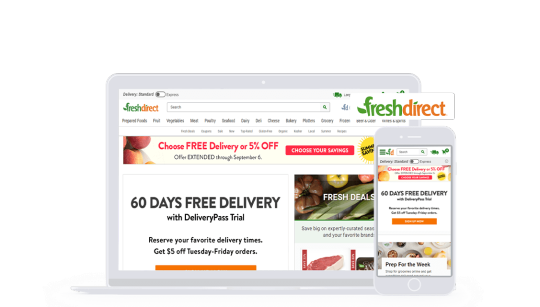
Data Scraping: The Foundation of Fresh Direct's Grocery Service
Data scraping is the process of extracting information from websites, databases, and other online sources. Fresh Direct data scraping uses this technique to gather data on product availability, pricing, and customer preferences, among other things. This allows them to keep their website and app updated with real-time information, ensuring customers can access the freshest products and the most accurate pricing information.
Real-Time Inventory Management: Data scraping enables Fresh Direct to monitor their inventory in real time. This ensures that customers have access to accurate information about product availability and can make informed decisions while shopping. Fresh Direct's ability to keep inventory data up-to-date reduces the likelihood of customers encountering out-of-stock items, ultimately improving the shopping experience.
Dynamic Pricing: Fresh Direct uses data scraping to keep track of pricing information from competitors and adjust their own prices accordingly. This helps the company remain competitive while offering customers the best possible deals. With real-time pricing data at their disposal, Fresh Direct can dynamically adjust their prices, creating a win-win situation for both the company and its customers.
Data Extraction: Tailoring Services to Customer Needs
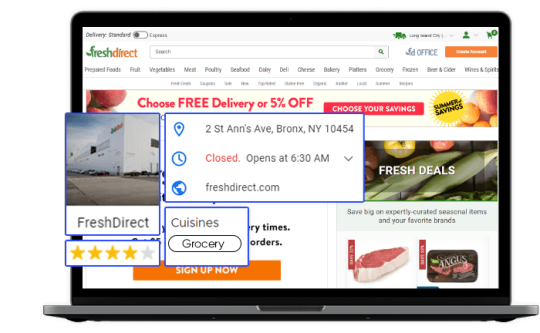
Data extraction is the process of retrieving specific information from large datasets. Fresh Direct leverages data extraction to gain insights into customer preferences, track order history, and personalize the shopping experience. This data-driven approach allows them to cater to individual customer needs more effectively.
Personalized Recommendations: Fresh Direct extracts data on customer purchase history and preferences to provide personalized product recommendations. By analyzing a customer's previous orders and shopping habits, the platform can suggest items that are likely to align with their tastes and needs. This not only enhances the customer's shopping experience but also boosts sales for Fresh Direct.
Efficient Supply Chain Management: Data extraction helps Fresh Direct optimize their supply chain by extracting data related to product demand and order patterns. With this information, the company can ensure that the right products are stocked in the right quantities, reducing waste and improving overall efficiency.
Targeted Marketing: Fresh Direct uses data extraction to segment their customer base and create targeted marketing campaigns. By extracting data on customer demographics, shopping behavior, and preferences, they can tailor their promotions, email campaigns, and advertisements to specific groups, increasing the likelihood of engagement and sales.
The Benefits of Data-Driven Grocery Services
The integration of data scraping and data extraction into Fresh Direct's operations provides several key benefits to both the company and its customers:
Improved Customer Experience: Real-time inventory updates and personalized recommendations lead to a more seamless and enjoyable shopping experience for Fresh Direct customers. They can trust that the products they want are available and discover new items that match their tastes.
Competitive Pricing: Data scraping helps Fresh Direct maintain competitive pricing. By monitoring the market and adjusting their prices accordingly, they ensure customers receive the best deals on their grocery orders.
Increased Efficiency: Data extraction allows Fresh Direct to streamline its operations, reducing waste and optimizing the supply chain. This leads to improved operational efficiency and cost savings.
Enhanced Marketing: Data-driven marketing campaigns improve customer engagement and conversion rates. By delivering personalized offers and recommendations, Fresh Direct can increase customer loyalty and sales.
Conclusion
Data scraping and data extraction have become invaluable tools for Fresh Direct, helping the company deliver a superior grocery shopping experience to its customers. These techniques enable real-time inventory management, competitive pricing, personalized recommendations, and targeted marketing, ultimately making the grocery delivery service more efficient and customer-centric.
As Fresh Direct continues to refine its data-driven approach, it remains at the forefront of the online grocery industry, setting an example for other companies looking to leverage the power of data to enhance their services and meet the evolving needs of modern consumers.
#food data scraping#restaurant data scraping#food data scraping services#grocerydatascraping#zomato api#fooddatascrapingservices#restaurantdataextraction#grocerydatascrapingapi#fresh direct data scraping
0 notes
Text
How To Scrape Fresh Direct Grocery Delivery App Data?
You can easily use Fresh Direct Grocery delivery data scraping to get a clear and valued database, including different Grocery delivery data, reviews, locations, menus, mentions, etc.

#Scrape Fresh Direct Grocery Delivery Data#Fresh Direct Grocery Delivery App Data Scraping#Fresh Direct Grocery mobile app scraping#Fresh Direct Grocery web extraction services
0 notes
Text
How To Scrape Instacart Grocery Delivery App Data?
Scrape Instacart Grocery Delivery Data - Instacart Grocery Delivery App Data Scraping
You can easily use Instacart Grocery delivery data scraping to get a clear and valued database, including different Grocery delivery data, reviews, locations, menus, mentions, etc., from Instacart Grocery with no technical issues.
About Instacart
Instacart is the market leader in North America for online grocery and among the fastest-growing e-commerce companies. Instacart’s same-day pickup and delivery services help reach daily essentials and fresh groceries to busy people across the U.S. and Canada in as quickly as an hour! Since its inception in 2012, Instacart has become an essential service for millions of families, serving as a direct and flexible earning opportunity for thousands of shoppers. The company has partnered with over 350 retailers and makes deliveries from over 25,000 stores across over 5,500 cities within North America. Instacart is available to around 85% of homes in the U.S. and over 70% of homes in Canada.
People use Instacart worldwide to discover eating places. Instacart assists you in choosing where to eat; it doesn’t know your location. Many Grocery enthusiasts post reviews and share images so that you find everything for making a decision. Do you need excellent Grocery databases? Grocery Data Scrape offers the best Instacart Grocery delivery app data scraping services, as we are skilled in scraping the Instacart database according to your needs. You can use our Instacart data scraping services could be used to do grocery marketing needs. Scraping Instacart Grocery data could be helpful for people that need to create business directories or do research & analysis.
Which Data Fields Can You Scrape from Instacart Grocery Delivery App?
With Food Data Scrape, it’s easy to scrape data fields from Instacart like:
Grocer Name
Address
Geoc0ordinates
Product Name
Product Image
Product SKU
Product Category
Product Descriptions
Product Price
Offers
Services Available
Shipping Charges
Ratings
Reviews
How to Scrape Region-Wise Data from Instacart Grocery Delivery Data?
Scraping region-wise data can be annoying, mainly if you don’t understand how to do it. Having manual data supplies requires good resources and sufficient time. Our Instacart Grocery data scraping services can help you find images, data, files, etc., used in grocery, get data about how to make different menus, and extract region-wise Instacart Grocery data to get quick data. With Instacart Grocery mobile app scraping, it’s easy to get optimal data suitable for you because they get an immense database, which is easily serviceable. Food Data Scrape provides the best Instacart Grocery web extraction services to extract region-wise data for menus and locations.
How to Scrape Instacart Grocery Delivery Data?
Scraping Instacart Grocery data is a hard job to do, particularly if you don’t know the way to do it. Gathering manual information needs different things with sufficient time. You can use our Instacart Grocery web extraction service in various analytics and data professionals for different business app needs. They are authentic and offer available results. You can get data, files, images, etc., with Instacart Grocery delivery app data scraping, find the most relevant data for you, and utilize Instacart Grocery delivery data scraping to avoid tedious work.
Is it possible to scrape Instacart Grocery Competitive Menu Prices Data?
Instacart Grocery ordering application data scraping helps you scrape data like Grocery pricing, menus, grocery names, and item modifiers that are extremely important for many Grocery businesses. You can defend site IPs from getting blocked, frequently remove identical data, and set pricing menu valuation events. We extract site images using confidential data because it is essential for any business. Well-balanced data is crucial as you can utilize it for market analysis.
What about Scraping Discounts, Delivery Charges, Packaging, and Services Data?
Food Data Scraping works with different formats. You can scrape data from other sources open in various forms if you want data fields like reviews, text, pricing, product descriptions, and digital resources. Using web scraping services, you can achieve volumes and variety that scrape different data volumes, get cut-pricing data, item-related services, delivery charges, and packaging, and find sensitive data that don’t make settlements precisely. Product and pricing data regularly alter at different intervals because of updates on the standard structure or changing prices to be aggressive. You don’t need to lose updates; you can reschedule scaping daily, weekly, or monthly.
To know more about Instacart Grocery delivery app data scraping, you can contact Food Data Scrape. We also offer web and mobile scraping services at reasonable prices. Know more : https://www.fooddatascrape.com/how-to-scrape-instacart-grocery-delivery-app-data.php
#Instacart Grocery delivery app data scraping#Scraping Instacart Grocery data#Instacart Grocery web extraction#Instacart Grocery mobile app scraping
0 notes
Text
How to Enhance Grocery Industry Expansion with Grocery Delivery Data Scraping?

The rise of online grocery delivery platforms has transformed how people shop for groceries, eliminating the need for weekly visits to physical stores. This industry witnesses significant growth, with a projected annual revenue increase of 20% from 2021 to 2031. Popular websites and apps such as DoorDash, Amazon Fresh, and InstaCart have experienced a surge in orders.
Online grocery delivery services have thrived thanks to advancements in digital technology, robust logistics, and increasingly hectic personal and professional lives. For those looking to expand existing services or embark on a new venture, web scraping grocery data emerges as a powerful solution to help achieve their business objectives.
Online grocery shopping has become an essential user service in today's fast-paced world. Customers no longer need to visit physical stores to browse products, as their time is increasingly limited. The growing demand for convenience is propelling the online grocery market forward. By 2022, roughly 10% of all grocery sales will occur online, amounting to a staggering $133.8 billion in value.
List Of Data Fields
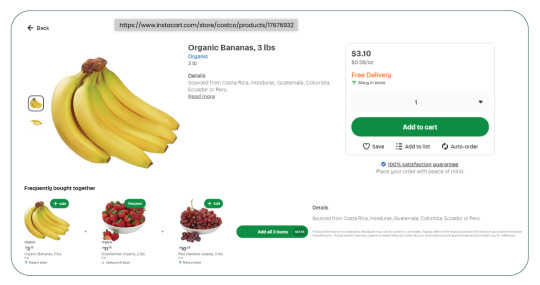
Product Full Name
Product SKU/Code
Image Product URL
Category of Product
Subcategories
Product Price
Discounted Price
Product Savings
Cost of Shipping
Description of Product
Specification of Product
Details Seller
Best Deals on Popular Products
Offer Best
Sellers Best
Offers Combo
Why Scrape Grocery Delivery Data?
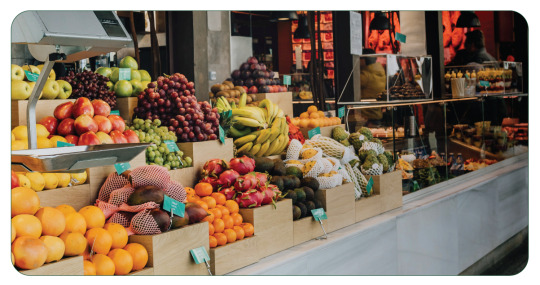
Scraping grocery delivery data offers numerous benefits for businesses and consumers:
Competitive Analysis: It allows businesses to gather competitors' data and analyze their pricing strategies, product offerings, and delivery services to gain a competitive edge.
Pricing Optimization: By scraping pricing data from various grocery delivery services, businesses can make informed pricing decisions to attract and retain customers.
Product Availability: Monitoring product availability and stock levels helps businesses meet customer demand and avoid stockouts.
Market Trends: Scrape grocery delivery data to provide insights into market trends, helping businesses adapt to changing consumer preferences and emerging product categories.
Customer Convenience: Consumers can use scraped data to compare grocery delivery options, find the best deals, and streamline their shopping experience, ultimately saving time and money.
How Can Grocery Data Scraping Help Enhance Business Success?

Grocery delivery data scraping is a potent catalyst for business success in the ever-evolving world of online grocery retail. Aggregating data from various sources equips businesses with the intelligence to make informed decisions that drive growth and competitiveness. It offers a competitive advantage by providing insights into pricing strategies, product assortments, and service offerings of rivals. Real-time pricing data enables businesses to optimize pricing strategies, attracting and retaining customers while ensuring profitability. Monitoring product availability and stock levels minimizes the risk of stockouts, ensuring a seamless customer experience. Insights into market trends and consumer preferences help businesses adapt staying ahead of changing demands. In addition, customer behavior analysis allows for tailored services, ultimately boosting customer satisfaction. Automating data collection using grocery data scraper saves time and resources, directing efforts toward strategic planning and operational efficiency. Whether expanding into new regions or diversifying product lines, grocery data scraping services empower businesses to make data-driven choices and enhance their prospects of success in the dynamic grocery sector. Web scraping grocery delivery data is a versatile tool with various applications, benefiting many stakeholders in the rapidly growing online grocery market. Whether you are an established grocery retailer, an online merchant, a bulk grocery dealer, a competitor in the grocery platform sector, or a business planning expansion, web scraping provides unique advantages:
Grocery Retailers: If you currently operate a brick-and-mortar grocery business, transitioning to an online model can provide customers with enhanced convenience. To ensure a successful transition, analyzing local competitors' offerings is crucial. Web scraping services can help you gain insights into local grocers' products, pricing, and strategies. This data can guide your marketing efforts and ensure a competitive edge when joining popular grocery delivery platforms.
Online Retailers: Incorporating groceries can boost sales and revenue for online retailers offering products across various categories. High-quality grocery items can attract a broader customer base, increasing sales in other product categories. Web scraping allows you to identify the most appealing grocery products and refine your offerings accordingly.
Bulk Grocery Dealers: If you are a bulk grocery dealer catering to retailers, web scraping can provide invaluable insights into customer preferences. Collecting data from product ratings and reviews can comprehensively understand popular product categories across different regions. This information helps you tailor your offerings to attract more retailers seeking bulk grocery supplies.
Grocery Platform Competitors: In an industry with regular new entrants, staying competitive is essential. Web scraping can significantly enhance your business strategy if you operate or plan to launch an online grocery platform. By scraping data from competitor platforms, you can gather critical insights into market dynamics, best-selling products, pricing strategies, and more. This valuable information gives your business a substantial competitive advantage.
Business Expansion: Expanding your grocery delivery services to new cities or regions requires thorough market research. A customized web scraping solution is instrumental in this process. By leveraging location-specific data, you can gain a detailed overview of existing grocery delivery services and sellers in the target area. This information allows you to align your expansion plans with local market expectations and requirements, increasing your chances of success.
Use Cases Of Grocery Delivery Data Scraping
Extracting grocery delivery data can offer consumers and businesses a wide range of valuable use cases. Here are these use cases explained in more detail:
Price Comparison: Grocery delivery data can be scraped from various sources to compare the prices of different products across multiple online retailers or local stores. It enables consumers to find the most cost-effective options for their groceries.
Product Research: Scraping data from grocery websites provides detailed information about grocery products, such as descriptions, nutritional facts, customer reviews, and ratings. This information empowers consumers to decide which products to buy, considering factors like quality and suitability for their needs.
Stock Availability: Consumers can scrape grocery data to check the real-time stock availability of products. It helps prevent disappointment by ensuring that the desired items are in stock before placing an order, which is particularly important for popular or seasonal items.
Shopping List Creation: Using scraped data, consumers can create customized shopping lists. They can browse available products, add them to their lists, and plan their grocery shopping more efficiently, ensuring they remember all essential items.
Price Tracking: Scraped data allows consumers to track price changes. It enables them to identify price drops, discounts, and the optimal time to purchase, saving money.
Market Analysis: For businesses, scraping grocery delivery data provides valuable insights into market trends, popular products, and customer preferences. This information is crucial for making strategic decisions and adjustments to meet market demands effectively.
Personalized Recommendations: Using scraped data, businesses, and online grocery platforms can offer personalized product recommendations to customers. These recommendations are based on individual preferences, past purchase history, and browsing behavior, enhancing the shopping experience.
Promotions and Marketing: Businesses can use scraped data to identify marketing opportunities and promotional strategies. This data helps target specific customer segments effectively and create marketing campaigns that resonate with their audience.
At Product Data Scrape, we maintain the highest ethical standards in all operations, including Competitor Price Monitoring and Mobile App Data Scraping. With a global presence spanning multiple offices, we consistently deliver exceptional and honest services to meet the diverse needs of our valued customers.
#GroceryDeliveryDataScraping#ScrapeGroceryDeliveryData#WebScrapingGroceryData#OnlineGroceryRetailScraping#GroceryDeliveryDataExtraction#ExtractGroceryDeliveryData#ScrapeGroceryDelivery
0 notes
Text
Elevate Your Grocery e-Stores Digital Strategy with the Power of Grocery Data Scraping

Digital retail has ushered in a transformative shift in consumer purchasing patterns and expectations, particularly in food and grocery markets. Projections indicate that the digital grocery sector will burgeon into a $203 billion market in the U.S. by 2025. Factors such as the pandemic and inflation have propelled more consumers toward e-stores, seeking the dual benefits of convenience and competitive pricing. Presently, major grocery and Consumer Packaged Goods (CPG)/Fast-Moving Consumer Goods (FMCG) brands have established and sustained a robust online presence. They distribute their products across prominent eCommerce platforms, Direct-to-Consumer (DTC) websites, and dedicated grocery applications.
In 2022, online grocery sales constituted 10.5% of the U.S. e-grocery market. Forecasts indicate a gradual ascent, with online grocery sales projected to reach a 12.6% share by 2027, underscoring the sector's sustained digital expansion.
However, a noteworthy development since 2022 has been the swifter escalation of online grocery prices compared to other eCommerce categories. It has intensified the quest for cost-effective alternatives among digital shoppers using grocery data scraping services , a considerable portion of whom belong to the price-sensitive millennial demographic. Consequently, grocery retailers seek productive, dependable, and profitable digital strategies. This pursuit encompasses comprehensive assessments of existing retail management systems and capabilities, ensuring they can adeptly meet demand and outpace competitor activities.
Despite a swiftly evolving industry, success hinges on critical considerations. Parameters such as quality, price competitiveness, convenience vis-a-vis customer loyalty, and the dynamic interplay between private labels and cherished brands have emerged as pivotal determinants. Scrape grocery delivery data to navigate these considerations has been imperative for brands striving to carve their niche in digital grocery retail's dynamic and competitive landscape.
Mastering Success In Online Grocery: Seven Key Strategies

In business, gauging success often involves scrutinizing financial metrics like sales growth, market share, and efficiency. Yet, these indicators are in a set of discernible "preference drivers" reflecting contemporary customer needs and industry trends. In the fiercely competitive and ever-evolving grocery landscape, retailers positioning themselves atop the digital shelf have adeptly aligned with these drivers.
Price & Discounts: Amidst the economic uncertainties of 2023, an upswing in price-conscious shoppers has underscored the pivotal role of pricing. Strategic discounting becomes a linchpin in the digital arena, where consumers can swiftly locate the best-priced products. Clear, enticing promotions on critical items, savvy psychological pricing, and incentivizing customer loyalty through cashback and exclusive discounts emerge as potent strategies to sustain shopper engagement.
Quality:The perception of value is intricately woven with quality, presenting a multifaceted spectrum ranging from the freshness of produce to the treatment of shoppers. Private label products leverage cues from positioning, packaging, and store ambiance to communicate quality and appeal to budget-conscious shoppers. Holistic brand experiences, post-purchase satisfaction, and overall convenience contribute to this notion of quality.
Digital: Digital channels stand as indispensable for retail triumph. Retailers wielding platforms that deliver personalized, flexible, and efficient experiences gain a competitive edge. Seamless online experiences encompass accurate recommendations, interactive chatbots, easy navigation, and a robust omnichannel connection. Mimicking the in-store sense of exploration in the digital sphere becomes paramount for maximizing sales.
Operations: The nuts and bolts of retail operations, including inventory management, assortment planning, and store layout, form the backbone of effective functioning. Enriched product content with explicit imagery, detailed descriptions, real-time pricing, and availability data on digital platforms proves pivotal. Ineffective inventory management risks stockouts of high-demand items, jeopardizing Search Engine Results Page (SERP) rankings and customer satisfaction.
Convenience & Speed: Proximity, diverse product selections, and trendy assortments position a store as a one-stop shop. However, in the digital age, convenience and speed take center stage. Quick, flexible checkout options and efficient shipping, pickup, and returns empower customers to make informed decisions swiftly. Offering multiple shipping and return choices caters to a broad consumer base. Millennials and Gen Z prioritize rapid shipping, while delivery charges emerge as a critical deterrent across other demographics.
Diversification: A spectrum of services and diverse store offerings, coupled with operational efficiency, emerges as the linchpin for long-term success in the grocery e-store landscape. It caters to evolving consumer needs and ensures resilience in a competitive market.
Customer Experience: At the core of success lies an unparalleled customer experience—personalization, convenience, and responsiveness foster customer loyalty. Striving for an optimal balance between technological innovation and the human touch establishes a winning formula in the digital grocery industry.
Leading Grocery Retailers In 2023: Strategies For Success

Irrespective of a business's size or profitability, excelling in every aspect is a formidable challenge for retailers. Success hinges on the strategic allocation of finite resources, making trade-offs in commitment to specific pillars. Here, we delve into the triumphs of six prominent American grocery retailers, showcasing how they navigated these pillars to secure success.
Trader Joe's: A unique player in the grocery sector, Trader Joe's epitomizes value perception through its commitment to low prices and high quality. The absence of an online presence allows the company to channel resources into enhancing in-store experiences and maintaining affordability. Trader Joe's has cultivated a devoted customer base, with shoppers often sharing their finds on social media. Scrape Trader Joe’s grocery data to collect valuable information for market analysis and business intelligence. Gain a competitive edge with our accurate and timely data insights.
Wegmans: Wegmans attains a top-tier position, focusing on high-quality products and an unparalleled in-store experience. While not excelling in pricing, Wegmans compensates through perceived value. This commitment has earned it the title "America's favorite grocery retailer," showcasing the power of prioritizing specific pillars. Develop a script to scrape Wegmans Grocery data, collecting product details, prices, and availability. Utilize web scraping techniques to gather information for analysis and insights into Wegmans' offerings.
Costco: A powerhouse in bulk retail, Costco excels in price, quality, digital, and operations. With an emphasis on offering discounted goods in large volumes, Costco's warehouse-style approach caters to diverse consumer needs. The brand's online presence complements its physical stores, providing convenience to members. Scrape Costco grocery data to acquire valuable insights on product details, pricing, and availability for informed decision-making and strategic planning.
Amazon Fresh: A digital giant, Amazon Fresh employs aggressive pricing strategies to gain market share. Despite failing to lead in quality or convenience, Amazon's technological prowess and Prime membership perks make it a formidable competitor. Its seamless online experiences and leverage of its delivery network position Amazon Fresh among the top grocery chains. Scrape Amazon Fresh Grocery Data to collect vital information on product details, prices, and availability, enabling businesses to gain valuable insights for informed decision-making and strategic planning within the retail sector.
Kroger: As one of the largest grocery chains, Kroger blends cost-effective warehouse-style stores with a robust digital storefront. Innovations like the "fuel points" system, short 30-minute deliveries, and strategic digital investments have propelled Kroger into the forefront of digital progression. Weekly promotions, digital coupons, and smart-priced products contribute to its success. Scrape Kroger Grocery Data to collect crucial details regarding products, prices, and availability, facilitating businesses in acquiring valuable insights for strategic decision-making and comprehensive market analysis.
And A Few More:
Aldi and Lidl are German discount retailers with unbeatable prices, challenging even Amazon's influence on pricing.
WinCo: A minor player focusing on the right blend of price and quality, emphasizing retail basics.
Whole Foods is a premium grocery retailer competing on quality, offering organic and natural products across its stores.
The key to success lies not in prioritizing specific pillars universally but in tailoring strategies to fit the unique needs of each business. Retailers, attuned to the ever-evolving market, are leveraging advanced technology solutions to refine their plans and maintain a competitive edge in the dynamic grocery landscape.
Fostering Digital Shopper Engagement: Strategies For Value Creation
The digital shelf has recently emerged as the primary hub for modern shoppers seeking pricing and product data. The tech-savvy customer's ability to swiftly explore various options intensifies the competition among retailers to stand out. As prices rise, shoppers gravitate towards eCommerce platforms to identify cost-effective options, making it imperative for retailers to carve opportunities for savings through flexible delivery choices, user-friendly e-stores, and strategic pricing and discounting.
Smaller players like FreshDirect and NetGrocer have remarkably secured substantial shares in the online grocery delivery market, showcasing the competitiveness of smaller businesses against larger counterparts. Collaborations with services such as Doordash, Instacart, and Postmates, coupled with the introduction of curbside pickups during the early days of COVID-19, have played pivotal roles in alternative sales growth. The overarching trend emphasizes the significance of an omnichannel presence, proving a powerful strategy to boost sales by catering to diverse consumer needs.
Tech Strategies Unleashed: Data Analytics & Dynamic Pricing
While robot cashiers make headlines, the broader spectrum of AI applications is revolutionizing the grocery landscape. Regardless of size, companies are leveraging technology for forward-thinking initiatives encompassing assortment planning, big data processing, customer insights, and dynamic pricing. Dynamic pricing, a key driver for significant players like Amazon, involves real-time adjustments to pricing, benefiting revenue and offering customers improved deals on the fly.
According to Boris Planer, director of Planet, “as technology-driven data analysis becomes more prevalent, the tendency to connect with customers and mine data emerges as a crucial capability for the future”.
Navigating Price Wars With Tech Solutions
Amid relentless price wars, managing the influx of pricing strategy data demands tech-driven vigilance. Intelligence Node provides cutting-edge solutions to alleviate this burden, enhancing competitive advantage.
Our price optimization software automates retail pricing and inventory management, leveraging market trends to recommend the most profitable prices. AI-driven technology scrutinizes inventory levels, price elasticity, and competitive pricing to analyze ideal hikes and markdowns, restructuring the entire process for retailers.
Tech Solutions For Retail Triumph
Leading grocery retailers like Trader Joe's, Wegmans, Amazon, and Costco have ascended to prominence through superior business models and critical pillars fostering emotional connection and financial performance. Our suite of tools, including trend tracking, price monitoring, assortment intelligence, and user-friendly data feeds, seamlessly integrates into your tech stack. These tools enhance performance and profitability, making the journey to the pinnacle of customer preference more attainable for your retail business.
Product Data Scrape operates with a commitment to ethical standards across all facets, spanning Competitor Price Monitoring Services to Mobile Apps Data Scraping. Our global footprint ensures unparalleled and transparent services, catering to a broad spectrum of client requirements.
#GroceryDataScraping#ScrapeTraderJoesGroceryData#ScrapeAmazonFreshGroceryData#WegmansGroceryDataExtraction#ScrapeCostcoGroceryData#ScrapeKrogerGroceryData
0 notes
Text
How to Enhance Grocery Industry Expansion with Grocery Delivery Data Scraping?
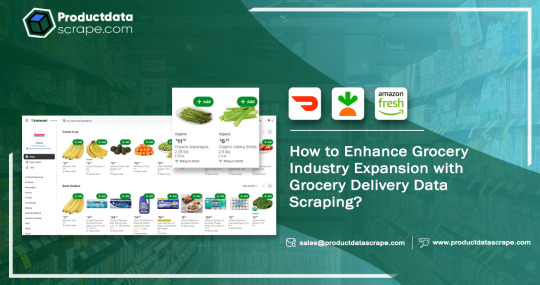
The rise of online grocery delivery platforms has transformed how people shop for groceries, eliminating the need for weekly visits to physical stores. This industry witnesses significant growth, with a projected annual revenue increase of 20% from 2021 to 2031. Popular websites and apps such as DoorDash, Amazon Fresh, and InstaCart have experienced a surge in orders.
Online grocery delivery services have thrived thanks to advancements in digital technology, robust logistics, and increasingly hectic personal and professional lives. For those looking to expand existing services or embark on a new venture, web scraping grocery data emerges as a powerful solution to help achieve their business objectives.
Online grocery shopping has become an essential user service in today's fast-paced world. Customers no longer need to visit physical stores to browse products, as their time is increasingly limited. The growing demand for convenience is propelling the online grocery market forward. By 2022, roughly 10% of all grocery sales will occur online, amounting to a staggering $133.8 billion in value.
List Of Data Fields
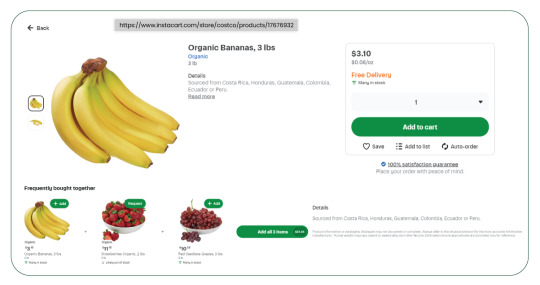
Product Full Name
Product SKU/Code
Image Product URL
Category of Product
Subcategories
Product Price
Discounted Price
Product Savings
Cost of Shipping
Description of Product
Specification of Product
Details Seller
Best Deals on Popular Products
Offer Best
Sellers Best
Offers Combo
Why Scrape Grocery Delivery Data?
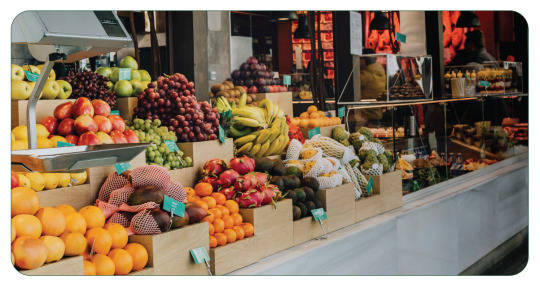
Scraping grocery delivery data offers numerous benefits for businesses and consumers:
Competitive Analysis: It allows businesses to gather competitors' data and analyze their pricing strategies, product offerings, and delivery services to gain a competitive edge.
Pricing Optimization: By scraping pricing data from various grocery delivery services, businesses can make informed pricing decisions to attract and retain customers.
Product Availability: Monitoring product availability and stock levels helps businesses meet customer demand and avoid stockouts.
Market Trends: Scrape grocery delivery data to provide insights into market trends, helping businesses adapt to changing consumer preferences and emerging product categories.
Customer Convenience: Consumers can use scraped data to compare grocery delivery options, find the best deals, and streamline their shopping experience, ultimately saving time and money.
How Can Grocery Data Scraping Help Enhance Business Success?
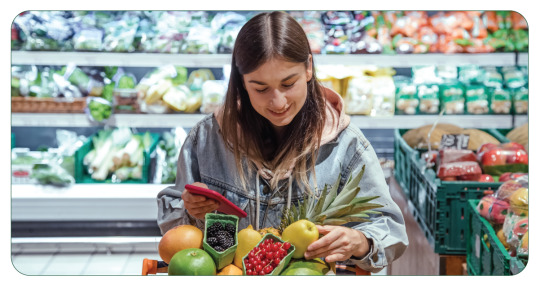
Grocery delivery data scraping is a potent catalyst for business success in the ever-evolving world of online grocery retail. Aggregating data from various sources equips businesses with the intelligence to make informed decisions that drive growth and competitiveness. It offers a competitive advantage by providing insights into pricing strategies, product assortments, and service offerings of rivals. Real-time pricing data enables businesses to optimize pricing strategies, attracting and retaining customers while ensuring profitability. Monitoring product availability and stock levels minimizes the risk of stockouts, ensuring a seamless customer experience. Insights into market trends and consumer preferences help businesses adapt staying ahead of changing demands. In addition, customer behavior analysis allows for tailored services, ultimately boosting customer satisfaction. Automating data collection using grocery data scraper saves time and resources, directing efforts toward strategic planning and operational efficiency. Whether expanding into new regions or diversifying product lines, grocery data scraping services empower businesses to make data-driven choices and enhance their prospects of success in the dynamic grocery sector. Web scraping grocery delivery data is a versatile tool with various applications, benefiting many stakeholders in the rapidly growing online grocery market. Whether you are an established grocery retailer, an online merchant, a bulk grocery dealer, a competitor in the grocery platform sector, or a business planning expansion, web scraping provides unique advantages:
Grocery Retailers: If you currently operate a brick-and-mortar grocery business, transitioning to an online model can provide customers with enhanced convenience. To ensure a successful transition, analyzing local competitors' offerings is crucial. Web scraping services can help you gain insights into local grocers' products, pricing, and strategies. This data can guide your marketing efforts and ensure a competitive edge when joining popular grocery delivery platforms.
Online Retailers: Incorporating groceries can boost sales and revenue for online retailers offering products across various categories. High-quality grocery items can attract a broader customer base, increasing sales in other product categories. Web scraping allows you to identify the most appealing grocery products and refine your offerings accordingly.
Bulk Grocery Dealers: If you are a bulk grocery dealer catering to retailers, web scraping can provide invaluable insights into customer preferences. Collecting data from product ratings and reviews can comprehensively understand popular product categories across different regions. This information helps you tailor your offerings to attract more retailers seeking bulk grocery supplies.
Grocery Platform Competitors: In an industry with regular new entrants, staying competitive is essential. Web scraping can significantly enhance your business strategy if you operate or plan to launch an online grocery platform. By scraping data from competitor platforms, you can gather critical insights into market dynamics, best-selling products, pricing strategies, and more. This valuable information gives your business a substantial competitive advantage.
Business Expansion: Expanding your grocery delivery services to new cities or regions requires thorough market research. A customized web scraping solution is instrumental in this process. By leveraging location-specific data, you can gain a detailed overview of existing grocery delivery services and sellers in the target area. This information allows you to align your expansion plans with local market expectations and requirements, increasing your chances of success.
Use Cases Of Grocery Delivery Data Scraping
Extracting grocery delivery data can offer consumers and businesses a wide range of valuable use cases. Here are these use cases explained in more detail:
Price Comparison: Grocery delivery data can be scraped from various sources to compare the prices of different products across multiple online retailers or local stores. It enables consumers to find the most cost-effective options for their groceries.
Product Research: Scraping data from grocery websites provides detailed information about grocery products, such as descriptions, nutritional facts, customer reviews, and ratings. This information empowers consumers to decide which products to buy, considering factors like quality and suitability for their needs.
Stock Availability: Consumers can scrape grocery data to check the real-time stock availability of products. It helps prevent disappointment by ensuring that the desired items are in stock before placing an order, which is particularly important for popular or seasonal items.
Shopping List Creation: Using scraped data, consumers can create customized shopping lists. They can browse available products, add them to their lists, and plan their grocery shopping more efficiently, ensuring they remember all essential items.
Price Tracking: Scraped data allows consumers to track price changes. It enables them to identify price drops, discounts, and the optimal time to purchase, saving money.
Market Analysis: For businesses, scraping grocery delivery data provides valuable insights into market trends, popular products, and customer preferences. This information is crucial for making strategic decisions and adjustments to meet market demands effectively.
Personalized Recommendations: Using scraped data, businesses, and online grocery platforms can offer personalized product recommendations to customers. These recommendations are based on individual preferences, past purchase history, and browsing behavior, enhancing the shopping experience.
Promotions and Marketing: Businesses can use scraped data to identify marketing opportunities and promotional strategies. This data helps target specific customer segments effectively and create marketing campaigns that resonate with their audience.
At Product Data Scrape, we maintain the highest ethical standards in all operations, including Competitor Price Monitoring Services and Mobile App Data Scraping. With a global presence spanning multiple offices, we consistently deliver exceptional and honest services to meet the diverse needs of our valued customers.
#GroceryDeliveryDataScraping#WebScrapingGroceryData#GroceryDataScraper#GroceryDataExtraction#ScrapeGroceryDeliveryData
0 notes
Text
Unveiling the Power of Fresh Direct Grocery Data Scraping and Extraction

In today's fast-paced digital world, data is the lifeblood of businesses. Access to accurate and timely data can make or break a company's success, especially in the highly competitive grocery industry. Fresh Direct, a leading online grocery delivery service, is no exception. With its vast selection of products and a commitment to freshness and quality, it's crucial for both customers and the company itself to stay updated on product availability, pricing, and more. This is where data scraping and extraction come into play, offering a powerful means to harness essential information.
Understanding Data Scraping and Extraction
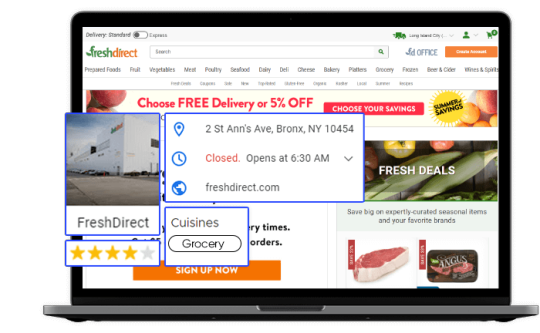
Data scraping is the process of automatically extracting data from websites and web pages. This is accomplished by using web scraping tools or software to access and retrieve specific information. In the context of Fresh Direct data scraping involves collecting data from their website, including product details, prices, stock levels, and more. This data is then structured and stored for analysis or integration into various applications.
The Importance of Fresh Direct Grocery Data
Fresh Direct boasts an extensive inventory of groceries, fresh produce, meat, dairy, and more. For customers, having access to real-time data about product availability, prices, and promotions is crucial for making informed purchasing decisions. On the other hand, for Fresh Direct itself, this data is invaluable for inventory management, pricing strategies, demand forecasting, and ensuring a seamless shopping experience for their customers.
Key Benefits of Fresh Direct Grocery Data Scraping
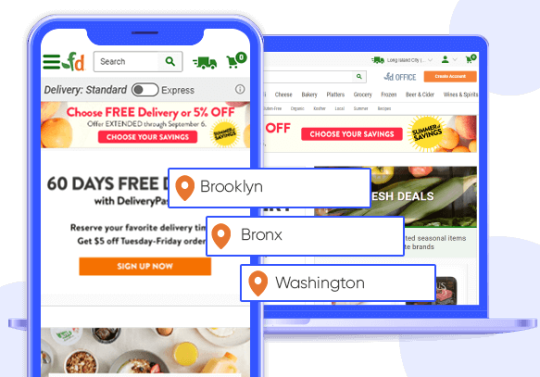
Real-time Product Information: Data scraping allows businesses to access up-to-the-minute data on product availability. For Fresh Direct customers, this means they can confidently plan their grocery shopping and choose from the freshest products available.
Competitive Pricing Analysis: By regularly scraping data from Fresh Direct's website, businesses can monitor pricing trends and adjust their own pricing strategies accordingly. This competitive advantage is essential in the grocery industry.
Inventory Management: Fresh Direct can optimize its inventory levels by tracking product demand and stock levels through data scraping. This ensures that customers can find the items they need and minimizes instances of products being out of stock.
Personalized Shopping Experiences: With data on customer preferences and purchasing habits, Fresh Direct can provide tailored recommendations and promotions to enhance the shopping experience.
Market Research: Data scraping from Fresh Direct's website can provide valuable insights into consumer preferences, helping businesses identify trends and potential gaps in the market.
Challenges and Ethical Considerations
While data scraping offers numerous advantages, it's important to acknowledge the challenges and ethical considerations that come with it. Websites may have terms of service that prohibit scraping, and scraping too aggressively can put a strain on a website's server or even lead to legal consequences. Additionally, respecting user privacy and adhering to data protection regulations are paramount when dealing with scraped data.
Tools and Technologies for Fresh Direct Grocery Data Scraping

Several tools and technologies can be used for data scraping, including:
Web Scraping Libraries: Python libraries like Beautiful Soup and Scrapy are popular choices for web scraping. They provide tools and methods for extracting data from websites.
APIs: Some websites, including Fresh Direct, offer APIs (Application Programming Interfaces) that allow developers to access data in a structured and authorized manner.
Data Scraping Services: There are third-party services and tools designed specifically for web scraping. These services often provide user-friendly interfaces and handle the technical aspects of scraping.
Data Storage and Analysis Tools: After scraping, data needs to be stored and analyzed. Databases like MySQL and analysis tools like Pandas and Jupyter Notebooks can be valuable for this purpose.
Conclusion
Fresh Direct grocery data scraping and extraction are powerful tools that offer a competitive edge to businesses in the grocery industry. Access to real-time product information, competitive pricing analysis, and improved inventory management are just a few of the benefits. However, it's essential to approach data scraping ethically and within the boundaries of legal and ethical guidelines. With the right tools and strategies, businesses can leverage Fresh Direct's data to enhance their operations and provide better services to their customers in an increasingly digital marketplace.
#grocerydatascraping#food data scraping services#food data scraping#restaurant data scraping#fooddatascrapingservices#restaurantdataextraction#web scraping services#zomato api#usa#grocerydatascrapingapi
0 notes
Link

Extract FreshDirect grocery delivery data from the internet and websites to aid your pricing policies and boost your business outcomes.
Contact - +1(832) 251 7311 (USA) ID - [email protected]
https://www.foodspark.io/how-web-scraping-is-used-to-extract-freshdirect-grocery-delivery-data.php
#Extract Fresh Direct Grocery Delivery Data#scraping Fresh Direct grocery delivery data#Scrape Fresh Direct Grocery Delivery Data#WebscrapingFreshDirectgrocerydata#FreshDirectgrocerydatascrapingservices#Monitoring Fresh Direct grocery delivery data
0 notes
Text
How To Scrape Fresh Direct Grocery Delivery App Data?

Scrape Fresh Direct Grocery Delivery Data - Fresh Direct Grocery Delivery App Data Scraping
You can easily use Fresh Direct Grocery delivery data scraping to get a clear and valued database, including different Grocery delivery data, reviews, locations, menus, mentions, etc., from Fresh Direct Grocery with no technical issues.
About Fresh Direct
The Fresh Direct Company is a principal grocery retailer in the United States. It functions over 1,300 supermarkets within 24 states across the US, mainly in the South, Southeast, Midwest, and Southwest. Over 1,050 of them are under Fresh Direct's name, having the remainder operating underneath names like King Soopers, Dillon Stores, and Fry's with its subsidiary, Dillon Companies, Inc. Over 93% of a company's sales come from grocery operations having maximum remainder coming from over 800 convenience stores. Dillon works under different names within 15 states. Fresh Direct also provides 37 food processing services that produce deli items, dairy products, bakery goods, and other grocery products.
People use Fresh Direct worldwide to discover eating places. Fresh Direct assists you in choosing where to eat; it doesn’t know your location. Many Grocery enthusiasts post reviews and share images so that you find everything for making a decision. Do you need excellent Grocery databases? Grocery Data Scrape offers the best Fresh Direct Grocery delivery app data scraping services, as we are skilled in scraping the Fresh Direct database according to your needs. You can use our Fresh Direct data scraping services could be used to do grocery marketing needs. Scraping Fresh Direct Grocery data could be helpful for people that need to create business directories or do research & analysis.
Which Data Fields Can You Scrape from Fresh Direct Grocery Delivery App?

With Food Data Scrape, it’s easy to scrape data fields from Fresh Direct like:
Grocery Name
Address
Geo Coordinates
Product Name
Product Image
Product SKU
Product Category
Product Descriptions
Product Price
Offers
Services Available
Shipping Charges
Ratings
Reviews
How to Scrape Region-Wise Data from Fresh Direct Grocery Delivery Data?
Scraping region-wise data can be annoying, mainly if you don’t understand how to do it. Having manual data supplies requires good resources and sufficient time. Our Fresh Direct Grocery data scraping services can help you find images, data, files, etc., used in grocery, get data about how to make different menus, and extract region-wise Fresh Direct Grocery data to get quick data. With Fresh Direct Grocery mobile app scraping, it’s easy to get optimal data suitable for you because they get an immense database, which is easily serviceable. Food Data Scrape provides the best Fresh Direct Grocery web extraction services to extract region-wise data for menus and locations.
How to Scrape Fresh Direct Grocery Delivery Data?
Scraping Fresh Direct Grocery data is a hard job to do, particularly if you don’t know the way to do it. Gathering manual information needs different things with sufficient time. You can use our Fresh Direct Grocery web extraction service in various analytics and data professionals for different business app needs. They are authentic and offer available results. You can get data, files, images, etc., with Fresh Direct Grocery delivery app data scraping, find the most relevant data for you, and utilize Fresh Direct Grocery delivery data scraping to avoid tedious work.
Is it possible to scrape Fresh Direct Grocery Competitive Menu Prices Data?

Fresh Direct Grocery ordering application data scraping helps you scrape data like Grocery pricing, menus, grocery names, and item modifiers that are extremely important for many Grocery businesses. You can defend site IPs from getting blocked, frequently remove identical data, and set pricing menu valuation events. We extract site images using confidential data because it is essential for any business. Well-balanced data is crucial as you can utilize it for market analysis.
What about Scraping Discounts, Delivery Charges, Packaging, and Services Data?
Food Data Scraping works with different formats. You can scrape data from other sources open in various forms if you want data fields like reviews, text, pricing, product descriptions, and digital resources. Using web scraping services, you can achieve volumes and variety that scrape different data volumes, get cut-pricing data, item-related services, delivery charges, and packaging, and find sensitive data that don’t make settlements precisely. Product and pricing data regularly alter at different intervals because of updates on the standard structure or changing prices to be aggressive. You don’t need to lose updates; you can reschedule scaping daily, weekly, or monthly.
To know more about Fresh Direct Grocery delivery app data scraping, you can contact Food Data Scrape. We also offer Food Data Scraping and Mobile Grocery App Scraping at reasonable prices.
#Scrape Fresh Direct Grocery Delivery Data#Fresh Direct Grocery Delivery App Data Scraping#Fresh Direct Grocery mobile app scraping#Fresh Direct Grocery web extraction services
0 notes